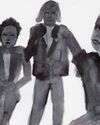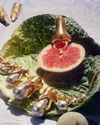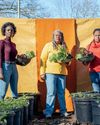At British label Stella McCartney, sustainability and commercial viability work in tandem to create an international luxury behemoth with a keen sense of social responsibility.

THE WORLD OF luxury is intrinsically linked to exotic furs and supple leather and its runway venues have long been the chosen grounds of protest by environmental activists. The call for action, till recent years, has largely gone unheard by the fashion industry. A rarity amongst her set, British designer Stella McCartney has grounded her eponymous label in the ways of ethical fashion.
“I grew up as a vegetarian, [on] a farm in the countryside and sustainability just stemmed from the fact that it made complete sense. I am in fashion and I do not use leather, fur or PVC. This is unheard of,” revealed Stella McCartney in an e-mail interview with T Singapore.
The namesake label, since its launch in 2001, has sidestepped the conventions of luxury, detaching from its frivolity and instead, driving forth a environmentally conscious and sustainable lifestyle. “I was always told that I’d never have an accessories business because people associate leather with luxury. But I am approaching it in a different way. We are the only luxury house providing this kind of product and proving it is doable,” said McCartney.
This story is from the May 2018 edition of T Singapore: The New York Times Style Magazine.
Start your 7-day Magzter GOLD free trial to access thousands of curated premium stories, and 9,000+ magazines and newspapers.
Already a subscriber ? Sign In
This story is from the May 2018 edition of T Singapore: The New York Times Style Magazine.
Start your 7-day Magzter GOLD free trial to access thousands of curated premium stories, and 9,000+ magazines and newspapers.
Already a subscriber? Sign In

Look At Us
As public memorials face a public reckoning, there’s still too little thought paid to how women are represented — as bodies and as selves.

Two New Jewellery Collections Find Their Inspiration In The Human Anatomy
Two new jewellery collections find their inspiration in the human anatomy.

She For She
We speak to three women in Singapore who are trying to improve the lives of women — and all other gender identities — through their work.
Over The Rainbow
How the bright colours and lively prints created by illustrator Donald Robertson brought the latest Weekend Max Mara Flutterflies capsule collection to life.

What Is Love?
The artist Hank Willis Thomas discusses his partnership with the Japanese fashion label Sacai and the idea of fashion in the context of the art world.

The Luxury Hotel For New Mums
Singapore’s first luxury confinement facility, Kai Suites, aims to provide much more than plush beds and 24-hour infant care: It wants to help mothers with their mental and emotional wellbeing as well.

Who Gets To Eat?
As recent food movements have focused on buying local or organic, a deeper and different conversation is happening among America’s food activists: one that demands not just better meals for everyone but a dismantling of the structures that have failed to nourish us all along.

Reimagining The Future Of Fashion
What do women want from their clothes and accessories, and does luxury still have a place in this post-pandemic era? The iconic designer Alber Elbaz thinks he has the answers with his new label, AZ Factory.

A Holiday At Home
Once seen as the less exciting alternative to an exotic destination holiday, the staycation takes on new importance.
All Dressed Up, Nowhere To Go
Chinese supermodel He Sui talks about the unseen pressures of being an international star, being a trailblazer for East Asian models in the fashion world, and why, at the end of the day, she is content with being known as just a regular girl from Wenzhou.